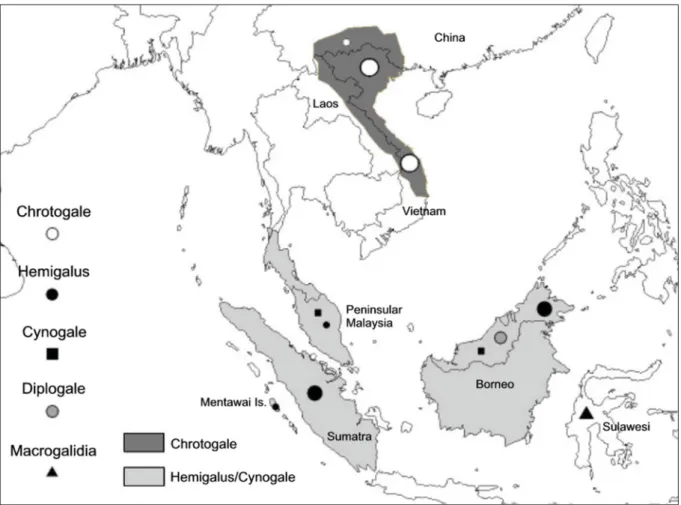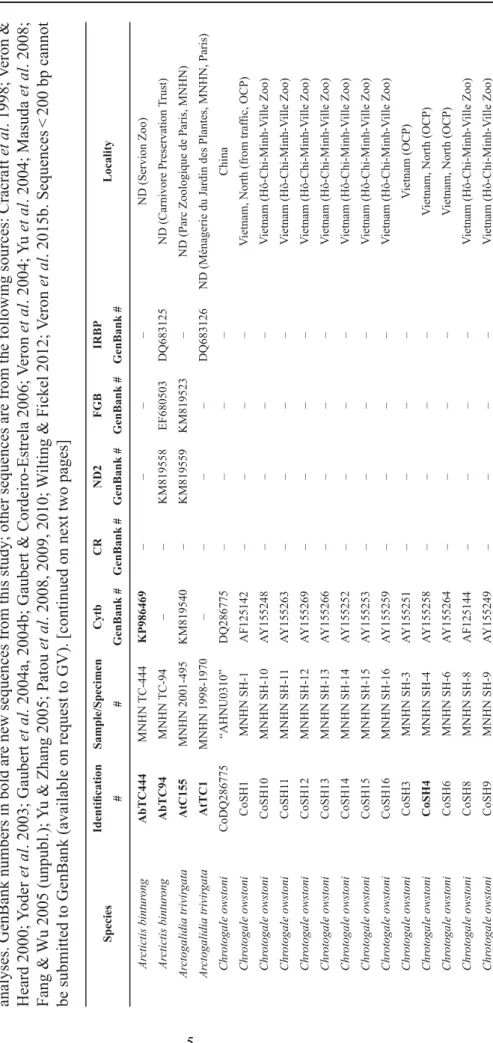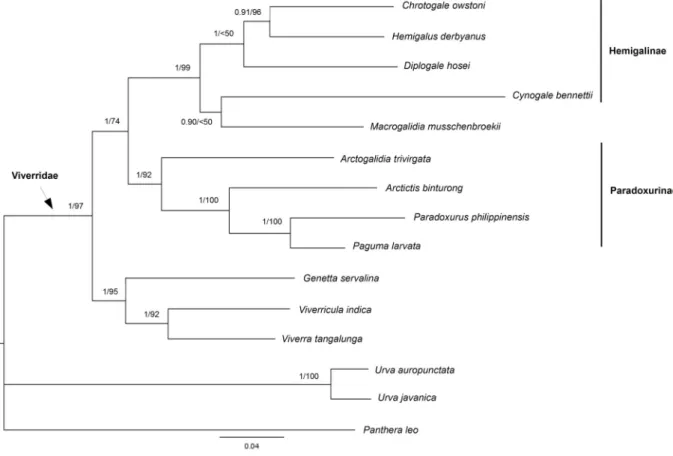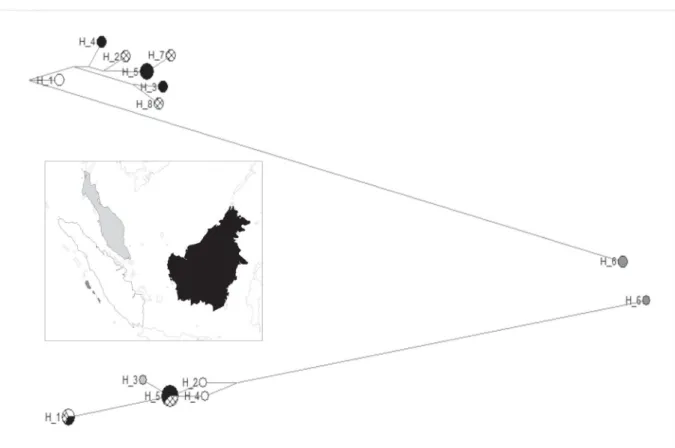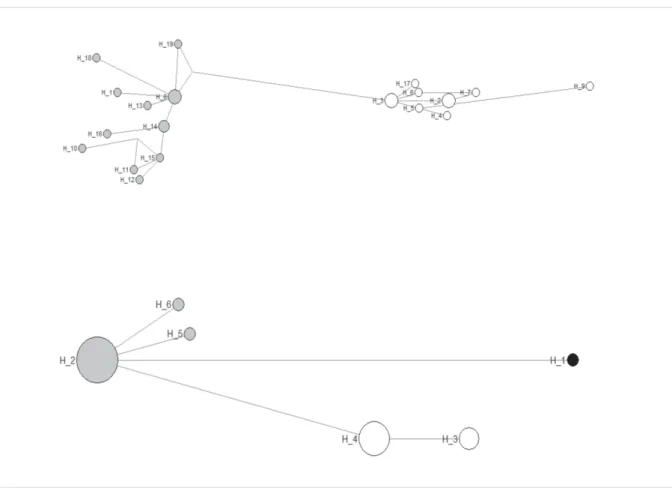http://dx.doi.org/10.5852/ejt.2017.285 www.europeanjournaloftaxonomy.eu 2017 · Veron G. et al.
This work is licensed under a Creative Commons Attribution 3.0 License.
D N A L i b r a r y o f L i f e , r e s e a r c h a r t i c l e
urn:lsid:zoobank.org:pub:EB6AF6D6-36E7-4677-87E8-D72C42A273AF
Molecular systematics and biogeography of the Hemigalinae civets (Mammalia, Carnivora)
Géraldine VERON
1,*, Céline BONILLO
2, Alexandre HASSANIN
3& Andrew P. JENNINGS
41,3
Institut de Systématique, Evolution, Biodiversité, UMR 7205 ISYEB, CNRS MNHN UPMC EPHE, Muséum national d’Histoire naturelle, Sorbonne Universités, CP 51, 57 rue Cuvier, 75231 Paris Cedex 05, France.
2
Service de Systématique moléculaire, UMS CNRS 2700, Muséum national d’Histoire naturelle, CP 26, 57 rue Cuvier, 75231 Paris Cedex 05, France.
4
SMALL CARNIVORES – Research and Conservation, 83 St. Lawrence Street, Portland, 04101 Maine, USA.
*
Corresponding author: veron@mnhn.fr
2
Email: bonillo@mnhn.fr
3
Email: hassanin@mnhn.fr
4
Email: smallcarnivores@yahoo.com
1
urn:lsid:zoobank.org:author:DE2A6A51-29F0-4A5E-A60B-C61AD5E1842E
2
urn:lsid:zoobank.org:author:7333D242-0714-41D7-B2DB-6804F8064B13
3
urn:lsid:zoobank.org:author:0DCC3E08-B2BA-4A2C-ADA5-1A256F24DAA1
4
urn:lsid:zoobank.org:author:3978AC9E-2C27-4B68-99DA-038B502AFDA8
Abstract. Due to the diffi culty in obtaining samples, the systematics of the Hemigalinae civets has not been fully resolved. The aim of this study was to clarify the relationships of the species and the intraspecifi c diversity within this subfamily, and to explore the environmental factors that might have affected its evolution. Using two mitochondrial and two nuclear markers, we confi rmed that the Hemigalinae comprises Owston’s civet, the otter civet, Hose’s civet and the banded civet, but also the Sulawesi palm civet (formerly included in the Paradoxurinae). Our study showed that the banded and Owston’s civets are sister species, and suggested that Hose’s civet is sister to these two. Within the banded civet, we observed a high divergence between individuals from the Mentawai Islands and those from Sumatra and Borneo (while the latter two were not strongly divergent), likely due to the deep sea channel between the Mentawai Islands and Sumatra. Unexpectedly, the Sumatran and Peninsular Malaysian individuals were not closely related, despite the fact that these two regions have repeatedly been connected during the last glaciations. No high polymorphism was found within Owston’s civet, although three groups were obtained: southern China, northern Vietnam and central Vietnam, which might be related to Pleistocene climatic fl uctuations.
Keywords. Southeast Asia, phylogeography, civets, Viverridae, molecular systematics.
Veron G., Bonillo C., Hassanin A. & Jennings A.P. 2017. Molecular systematics and biogeography of the Hemigalinae civets (Mammalia, Carnivora). European Journal of Taxonomy 285: 1–20. http://dx.doi.org/10.5852/
ejt.2017.285
Introduction
The subfamily Hemigalinae (Viverridae) comprises four species: Owston’s civet Chrotogale owstoni Thomas, 1912, the otter civet Cynogale bennettii Gray, 1837, Hose’s civet Diplogale hosei (Thomas, 1892), and the banded civet Hemigalus derbyanus (Gray, 1837), that are found in Southeast Asia and southern China (Jennings & Veron 2009; Fig. 1). Very little is known about their ecology, but they seem to be nocturnal, mainly terrestrial, and are primarily found in tropical forests (Veron et al. 2006; Jennings &
Veron 2009; Jennings et al. 2013). The banded civet and otter civet occur mainly in the lowlands, while Hose’s civet is primarily found at higher elevations (Veron et al. 2006; Jennings et al. 2013); Owston’s civet seems to be found both in lowland and montane forests (Jennings & Veron 2009). These species are of conservation concern, with the otter civet listed as Endangered and the other three as Vulnerable by the IUCN (2015), although there is a scarcity of data about their current population trends and sensitivity to environmental disturbance (Schreiber et al. 1989; Jennings & Veron 2009; Jennings et al. 2013).
The destruction and degradation of tropical forests are clearly major threats to this group (Meijaard &
Sheil 2008; Corlett 2009; Jennings et al. 2013). Despite these threats, little molecular systematics work has been done on this group; knowledge of their phylogenetic diversity, intraspecifi c genetic diversity and structure, and population differentiation is crucial for defi ning conservation priorities and for the identifi cation of evolutionarily signifi cant units (ESUs, Ryder 1986; Moritz 1994; Haig 1998; Isaac et al. 2007).
Fig. 1. Map showing the distribution of the samples of Hemigalinae used in this study. The gray shadings
show the range of Chrotogale owstoni Thomas, 1912, Cynogale bennettii Gray, 1837 and Hemigalus
derbyanus (Gray, 1837); Diplogale hosei (Thomas, 1892) is only found on Borneo and Macrogalidia
musschenbroekii (Schlegel, 1879) only occurs on Sulawesi. The size of the sample symbols corresponds
to the number of samples from each area (the smallest equals 1, and the largest equals 12–14).
The systematics of the Hemigalinae had previously only been assessed using morphological data (Pocock 1933; Gregory & Hellman 1939; Wozencraft 1989; Veron 1994, 1995) until Patou et al. (2008) proposed a molecular phylogeny of the Hemigalinae and Paradoxurinae. Patou et al. (2008) found that the banded civet and Owston’s civet were sister species, with the otter civet as the sister taxon to these two (as also obtained later by Agnarsson et al. 2010). Unfortunately, Hose’s civet and the Sulawesi palm civet Macrogalidia musschenbroekii (Schlegel, 1879) were missing from these molecular studies. Wilting &
Fickel (2012) provided data for these two species; they confi rmed that Hose’s civet is a member of the Hemigalinae, and found that the Sulawesi palm civet grouped with this subfamily (whereas it was previously classifi ed within the Paradoxurinae; Wozencraft 2005). However, their phylogenetic trees showed very low branch support for some taxa, and the relationships between the species of Hemigalinae were not resolved.
Very few studies have explored intraspecifi c variation within the species of Hemigalinae. Veron et al.
(2004) conducted a molecular study on Owston’s civet and obtained two main groups: northern and central Vietnam; however, samples from China were missing. Based on morphological features, two species for the otter civet have been proposed, Cynogale lowei Pocock, 1933 and C. bennettii, but examination of the only specimen available for C. lowei, and doubt about its geographic origin, led Veron et al. (2006) to consider C. lowei as a synonym of C. bennettii. Four subspecies of the banded civet were proposed by Wozencraft (2005): Hemigalus derbyanus derbyanus (Gray, 1837) (Myanmar, Peninsular Malaysia, Sumatra); H. d. boei Muller, 1838 (Borneo); H. d. minor Miller, 1903 (South Pagai Island, Mentawai Islands); and H. d. sipora Chasen & Kloss, 1927 (Sipora Island, Mentawai Islands).
However, Pocock (1933) had previously proposed that H. d. derbyanus ranged from Myanmar to the Malay peninsula, Sumatra and Borneo, and that H. d. minor comprises both the South Pagai and Sipora Island populations. Corbet & Hill (1992) did not fi nd any morphological support for these subspecies, and there has been no recent taxonomic revision of H. derbyanus. On the basis of a short mitochondrial fragment, Wilting et al. (2012) suggested a split of ca 2.7 million years between H. d. derbyanus and H. d. minor; unfortunately, they did not provide details about their dataset and results, and their sequences are not available in GenBank.
Tectonic movements, geographical and ecological barriers, and climatic variations across Southeast Asia have played important roles in the speciation and population structure of forest-dependent species (Meijaard 2009; Esselstyn et al. 2010; Shekelle et al. 2010; Woodruff 2010; Veron et al. 2014, 2015b, 2015c), and therefore, these might have affected the distribution and speciation of the Hemigalinae civets.
The distinction between the Indochinese and Sundaic faunas might have arisen as a result of the rapid sea-level changes along the Thai-Malay peninsula during the last fi ve million years, which caused local extirpations (Woodruff & Turner 2009), or it has been maintained by the ecological differences between these two subregions (Meijaard 2009). Within the Sundaic region, climate-induced sea-level changes have altered the topography repeatedly, exposing and fl ooding land corridors between the mainland and different islands, and ecological factors played a role in restricting movements of species across this region. For instance, during the Last Glacial Maximum (LGM), the central part of the Sundaland might have been covered by open habitat (Bird et al. 2005; Meijaard 2003; de Bruyn et al. 2014; but see also Woodruff 2010), which could have limited the exchanges of forest-dependent species between Borneo and the rest of the Sundaic region (Veron et al. 2014; 2015c), and this could have affected the Hemigalinae civets.
The aims of this study were to further clarify the relationships of the species within the Hemigalinae,
to study the intraspecifi c diversity and genetic structure within the banded and Owston’s civets, and
to explore the role of geographical barriers and environmental fl uctuations in shaping the structure
between and within species. We analysed three mitochondrial fragments, Cytochrome b, Control
Region and NADH dehydrogenase subunit 2, and two nuclear genes, Beta-fi brinogen intron 7 and inter-
photoreceptor retinoid binding protein (IPRB). Due to the elusive nature of the Hemigalinae civets and the diffi culties of obtaining fresh samples, the use of museum samples was crucial for this study.
Material and methods
Sampling, extraction, PCR and sequencing
We collected fresh (hair or tissue) and museum samples (from skins and tissues taken from skulls) from 51 individuals of nine species of Hemigalinae and Paradoxurinae (Table 1, Fig. 1). Total genomic DNA was isolated following a cetyltrimethyl ammonium bromide (CTAB)-based protocol (Winnepenninckx et al. 1993). For museum samples, we added dithiothreitol (DTT 1M, ca 15μl per extract) during tissue lysis to break up disulfi de bonds and we increased the lysis time (up to 72 hours).
We sequenced three mitochondrial fragments: Cytochrome b gene (Cytb), the control region (CR;
hypervariable region 1) and NADH dehydrogenase subunit 2 (ND2), using the primers from Veron et al.
(2004, 2014, 2015a), Patou et al. (2008, 2009) and Wilting & Fickel (2012). We sequenced the nuclear marker intron 7 of Beta-fi brinogen (FGB) using the primers of Yu & Zhang (2005). IRBP sequences were from previous studies (see Table 1).
Polymerase chain reactions (PCRs) were performed as in Patou et al. (2010), with annealing temperatures of 50°C for Cytb and ND2, 61°C for CR, and 59°C for FGB. PCR products were visualized on a 1.5%
agarose gel. PCR products were then purifi ed and sequenced in both directions on an automated DNA sequencer by Genoscope and Eurofi ns. Sequences obtained from DNA extracted from museum samples were amplifi ed and sequenced twice to ensure their quality and authenticity. Sequences were edited, assembled and aligned manually using Bioedit, version 7 (Hall 1999).
Phylogenetic and haplotype network analyses
Phylogenetic analyses were performed using neighbour-joining (NJ), maximum likelihood (ML) and maximum parsimony (MP) as implemented in MEGA6 (Tamura et al. 2013), and Bayesian inference (BI) using MrBayes 3.2 (Ronquist et al. 2012). We rooted the phylogenetic analyses with three Viverrinae (Genetta servalina Pucheran, 1855, Viverricula indica (Saint-Hilaire, 1803) and Viverra tangalunga Gray, 1832), one species of Felidae (Panthera leo (Linnaeus, 1758)) and two species of Herpestidae (Urva auropunctata (Hodgson, 1836) and U. javanica (Saint-Hilaire, 1818)). Individual loci were fi rst analysed independently and then combined.
For ML, the best-fi tting model was estimated prior to the analyses using MEGA6, following the Akaike information criterion (AIC). The selected model was then implemented in the ML analyses, using the Nearest-Neighbor-Interchange heuristic method and node robustness was assessed through 1000 bootstrap replicates. For the BI analysis combining the four genes (Cytb, ND2, FGB and IRBP), jModelTest v. 2.1.7 (Darriba et al. 2012) was used to evaluate the models of nucleotide substitution for each of the ten partitions (FGB and the three codon-positions for Cytb, ND2 and IRBP), following the Akaike information criterion. Bayesian analyses were then conducted using the selected GTR + I + G model for Cytb-1 and Cytb-3, GTR + G model for Cytb-2 and ND2-3, GTR model for FGB, HKY + I + G model for ND2-1, HKY + G model for ND2-2, HKY model for IRBP-1 and IRBP-3, and K80 model for IRBP-2. The posterior probabilities (PP) were calculated using four independent Markov chains run for 10 000 000 Metropolis-coupled MCMC generations, with trees sampled every 1000 generations and a burn-in of 25%.
Trees were visualized and edited using FigTree v. 1.4.0 (Rambaut 2012). We compared resulting topo- logies and their node support; nodes were considered as supported when posterior probabilities were
≥ 0.95 and bootstrap values were ≥ 70% (see Alfaro et al. 2003).
T able 1. List of the samples included in this study . For each sample, we report the identi fi cation number , the sample/specimen number (AHNU = Anhui Normal University , W uhu, China; BZM = Museum für Naturkunde, Berlin, Germany; FMNH = Field Museum of Natural History , Chi cago, IL, USA; ISEM = Institut des Sciences de l’Evolution, Montpellier , France; MCZ = Harvard Museum of Comparative Zoology , Cambridge, MA, USA; MNHN = Muséum national d’Histoire naturelle, Paris, France; RMNH = Rijksmuseum van Natuurlijke Historie, Naturalis, Leiden, the Netherlands), the GenBank numbers for the fi ve genes, and locality (OCP = specimens held at the Owston’ s Palm Civet Conservation Program, Cuc Phuong National Park, V ietnam; ND = no data). Identi fi cation numbers in bold indicate samples used in the Cytb + ND2 + FGB + IRBP dataset for the phylogenetic analyses. GenBank numbers in bold are new sequences from this study; other sequences are from the following sources: Cracraft et al . 1998; V eron & Heard 2000; Y oder et al . 2003; Gaubert et al. 2004a, 2004b; Gaubert & Cordeiro-Estrela 2006; V eron et al . 2004; Y u et al . 2004; Masuda et al . 2008; Fang & W u 2005 (unpubl.); Y u & Zhang 2005; Patou et al . 2008, 2009, 2010; W ilting & Fickel 2012; V eron et al . 2015b. Sequences < 200 bp cannot be submitted to GenBank (available on request to GV). [continued on next two pages]
SpeciesIdentifi cationSample/SpecimenCytbCRND2FGBIRBP Locality ##GenBank #GenBank #GenBank #GenBank #GenBank # Arctictis binturongAbTC444MNHN TC-444KP986469––––ND (Servion Zoo) Arctictis binturongAbTC94MNHN TC-94––KM819558EF680503 DQ683125ND (Carnivore Preservation Trust) Arctogalidia trivirgataAtC155MNHN 2001-495KM819540–KM819559KM819523–ND (Parc Zoologique de Paris, MNHN) Arctogalidia trivirgataAtTC1MNHN 1998-1970––––DQ683126ND (Ménagerie du Jardin des Plantes, MNHN, Paris) Chrotogale owstoniCoDQ286775“AHNU0310”DQ286775––––China Chrotogale owstoniCoSH1MNHN SH-1AF125142––––Vietnam, North (from traffi c, OCP) Chrotogale owstoniCoSH10MNHN SH-10AY155248––––Vietnam (Hô-Chi-Minh-Ville Zoo) Chrotogale owstoniCoSH11MNHN SH-11AY155263––––Vietnam (Hô-Chi-Minh-Ville Zoo) Chrotogale owstoniCoSH12MNHN SH-12AY155269––––Vietnam (Hô-Chi-Minh-Ville Zoo) Chrotogale owstoniCoSH13MNHN SH-13AY155266––––Vietnam (Hô-Chi-Minh-Ville Zoo) Chrotogale owstoniCoSH14MNHN SH-14AY155252––––Vietnam (Hô-Chi-Minh-Ville Zoo) Chrotogale owstoniCoSH15MNHN SH-15AY155253––––Vietnam (Hô-Chi-Minh-Ville Zoo) Chrotogale owstoniCoSH16MNHN SH-16AY155259––––Vietnam (Hô-Chi-Minh-Ville Zoo) Chrotogale owstoniCoSH3MNHN SH-3AY155251––––Vietnam (OCP) Chrotogale owstoniCoSH4MNHN SH-4AY155258––––Vietnam, North (OCP) Chrotogale owstoniCoSH6MNHN SH-6AY155264––––Vietnam, North (OCP) Chrotogale owstoniCoSH8MNHN SH-8AF125144––––Vietnam (Hô-Chi-Minh-Ville Zoo) Chrotogale owstoniCoSH9MNHN SH-9AY155249––––Vietnam (Hô-Chi-Minh-Ville Zoo)SpeciesIdentifi cationSample/SpecimenCytbCRND2FGBIRBP Locality ##GenBank #GenBank #GenBank #GenBank #GenBank # Chrotogale owstoniCoT2092MNHN T-2092AY155262–DQ683984EF680505DQ683127Vietnam, North Chrotogale owstoniCoTC186MNHN TC-186AY155261––––Vietnam, North (OCP) Chrotogale owstoniCoTC187MNHN TC-187AY155267––––Vietnam, North (OCP) Chrotogale owstoniCoTC188MNHN TC-188AY155250––––Vietnam, North, Kim Boi, Hoa Binh (OCP) Chrotogale owstoniCoTC189MNHN TC-189AY155268––––Vietnam (OCP) Chrotogale owstoniCoTC190MNHN TC-190AY155270––––Vietnam (OCP) Chrotogale owstoniCoTC191MNHN TC-191AY155260––––Vietnam (captive born, OCP) Chrotogale owstoniCoTC193MNHN TC-193AY155256––––Vietnam (captive born, OCP) Chrotogale owstoniCoTC197MNHN TC-197AY155271––––Vietnam (OCP) Chrotogale owstoniCoTC204MNHN TC-204AY155255––––Vietnam, Center, Binh Dinh (OCP) Chrotogale owstoniCoTC205MNHN TC-205AY155254––––Vietnam, North, Nghe An (OCP) Chrotogale owstoniCoTC206MNHN TC-206AY155265––––Vietnam, North, Nghe An (OCP) Chrotogale owstoniCoTC207MNHN TC-207AY155257––––Vietnam, North, Van Ban, Lao Cai Province Cynogale bennettiiCbM1962MNHN 1962-170KP986470–KP986485––Malaysia, Malacca Cynogale bennettiiCbTC147MNHN TC-417DQ683992–DQ683983––Borneo, Sarawak (Negara Zoo, Kuala Lumpur) Diplogale hoseiDhF88298FMNH 88298KP986471–KP986486––Malaysia, Borneo, Sarawak, Kelabit Plateau, Pa Umur Diplogale hoseiDhJQ219112RMNH 34568JQ219112–JQ219110––Malaysia, Borneo, Sarawak, Salekan Mt Diplogale hoseiDhJQ219111BZM 14291––JQ219111––Brunei, Marabok Mt Hemigalus derbyanusHdC38647MCZ 38647KP986472––––Indonesia, Sumatra, East, Little Siak river Hemigalus derbyanusHdM24MNHN 1886-24KU696424––––Indonesia, Sumatra, Palembang Hemigalus derbyanusHdM489MNHN 1865-489KU696425––––Malaysia, peninsular Malaysia, Penang Island Hemigalus derbyanusHdR34643RMNH 34643KU696426––––Indonesia, Borneo Hemigalus derbyanusHdR5109RMNH 5109KU696427––––Indonesia, Sumatra, Atjeh, Rampaih Hemigalus derbyanusHdTC09MNHN TC-09AF125143KP986468AY170052KP986482AY170082ND (Singapore Zoo) Hemigalus derbyanusHdTC20MNHN TC-20KP986473––––Malaysia, Borneo, Sarawak (Cincinnati Zoo) Hemigalus derbyanusHdTC21MNHN TC-21<200bpKP986463–––Malaysia, Borneo, Sabah, Danum Valley
Hemigalus derbyanusHdTC22MNHN TC-22AY155273–DQ683987KP986479–Malaysia, Borneo, Sabah, Danum Valley Hemigalus derbyanusHdTC23MNHN TC-23AY155272KP986464–EF680508 –Malaysia, Borneo, Sabah, Danum Valley Hemigalus derbyanusHdTC286MNHN TC-286KP986474KP986465–KP986480–Indonesia, Siberut Is., Mentawai Is., N Muarasiberut Hemigalus derbyanusHdTC300MNHN TC-300KP986475KP986466–KP986481–Indonesia, Borneo, W Kalimantan, Kerapa Bejali Hemigalus derbyanusHdTC411MNHN TC-411KP986476KP986467–KU696429–Malaysia (Negara Zoo, Kuala Lumpur) Hemigalus derbyanusHdTC756MNHN TC-756KU696428––––Sumatra? (Batu Secret Zoo & Maharani Zoo, Java) Macrogalidia musschenbroekiiMmJQ219116RMNH aJQ219116–JQ219113––Indonesia, Sulawesi, Manado-Kinilo Macrogalidia musschenbroekiiMmJQ219114RMNH 32244––JQ219114––Indonesia, Sulawesi, Amurang Macrogalidia musschenbroekiiMmJQ219115RMNH 32243––JQ219115––Indonesia, Sulawesi, Amurang Macrogalidia musschenbroekiiMmM1868MNHN 1868-1327KP986477–KP986487––Indonesia, Sulawesi Paguma larvataPlAB303959“SE4”AB303959––––Thailand Paguma larvataPlAY525040–––––AY525040China, Yunnan Province Paguma larvataPlC72MNHN C-72––DQ683990––ND Paguma larvataPlL92MNHN L-92–––KP986483–China, Guangxi Paradoxurus philippinensisPhF3167FMNH LRH 3167AY170113FJ881543AY170056EF680510AY170086Philippines, Leyte Island Genetta servalinaGsISEM T-4620AF511053–AY170058EF680507AY170088Gabon Viverricula indicaViMNHN TC-25––––DQ267568Madagascar Viverricula indicaViMNHN TC-177AY241890––––Taiwan Viverricula indicaViMNHN TC-256––DQ683991––Thailand Viverra tangalungaVtFMNH LRH 4121AY170112– AY170055–AY170085Philippines Viverra tangalungaVtMNHN TC-534–––EF680512–Malaysia Panthera leoPleo–AF053052–AY170043AY634374AY170073ND Urva auropunctataUa“Nellis”AY170108–AY170051–AY170081Caribbean islands Urva auropunctataUaMNHN TC-340––– FJ391194–Croatia, Korcula Island Urva javanicaUjMNHN TC-258KP986478– FJ391234KP986484– Thailand SpeciesIdentifi cationSample/SpecimenCytbCRND2FGBIRBP Locality ##GenBank #GenBank #GenBank #GenBank #GenBank #
